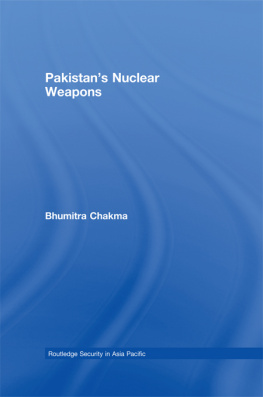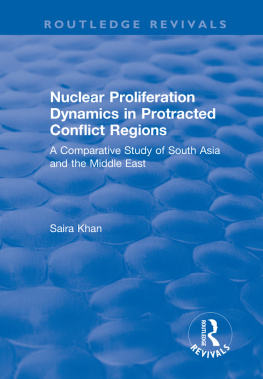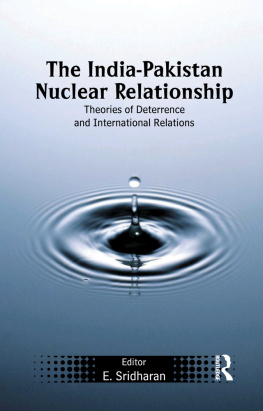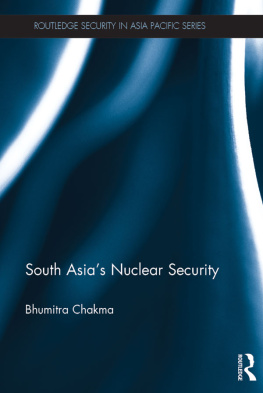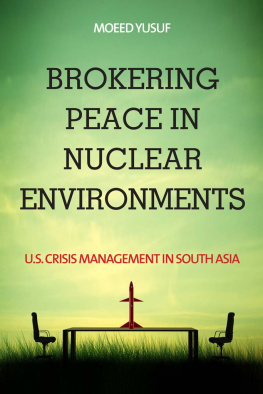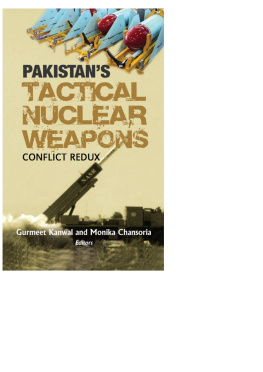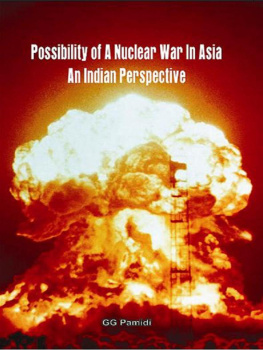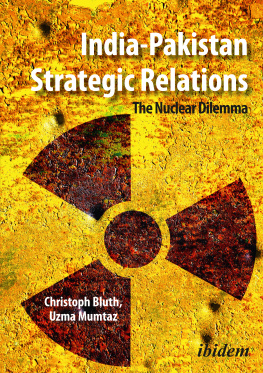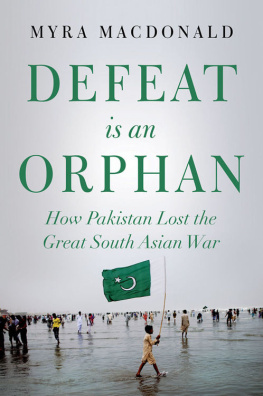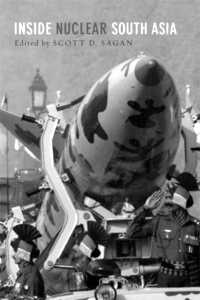South Asias Cold War
Asian Security Studies
Series Editors: Sumit Ganguly and
Indiana University, Bloomington
Andrew Scobell
US Army War College
Few regions of the world are fraught with as many security questions as Asia. Within this region it is possible to study great power rivalries, irredentist conflicts, nuclear and ballistic missile proliferation, secessionist movements, ethno-religious conflicts, and inter-state wars. This book series publishes the best possible scholarship on the security issues affecting the region, and includes detailed empirical studies, theoretically oriented case studies, and policy-relevant analyses as well as more general works.
- China and International Institutions
- Alternate paths to global power
- Marc Lanteigne
- Chinas Rising Sea Power
- The PLA Navys submarine challenge
- Peter Howarth
- If China Attacks Taiwan
- Military strategy, politics and economics
- Edited by Steve Tsang
- Chinese CivilMilitary Relations
- The transformation of the Peoples Liberation Army
- Edited by Nan Li
- The Chinese Army Today
- Tradition and transformation for the 21st century
- Dennis J. Blasko
- Taiwans Security
- History and prospects
- Bernard D. Cole
- Religion and Conflict in South and Southeast Asia
- Disrupting violence
- Edited by Linell E. Cady and Sheldon W. Simon
- Political Islam and Violence in Indonesia
- Zachary Abuza
- USIndian Strategic Cooperation into the 21st Century
- More than words
- Edited by Sumit Ganguly, Brian Shoup, and Andrew Scobell
- India, Pakistan and the Secret Jihad
- The covert war in Kashmir, 19472004
- Praveen Swami
- Chinas Strategic Culture and Foreign Policy Decision-Making
- Confucianism, leadership and war
- Huiyun Feng
- Military Strategy in the Third Indochina War
- The last Maoist war
- Edward C. ODowd
- Asia-Pacific Security
- US, Australia and Japan and the new security triangle
- William T. Tow, Satu Limaye, Mark Thomson, and Yoshinobu Yamamoto
- China, the United States and SouthEast Asia
- Contending perspectives on politics, security and economics
- Evelyn Goh and Sheldon W. Simon
- Conflict and Cooperation in MultiEthnic States
- Institutional incentives, myths and counter-balancing
- Brian Dale Shoup
- Chinas War on Terrorism
- Counter-insurgency, politics and internal security
- Martin I. Wayne
- US Taiwan Policy
- Constructing the triangle
- ystein Tunsj
- Conflict Management, Security and Intervention in East Asia
- Third-party mediation and intervention between China and Taiwan
- Edited by Jacob Bercovitch, Kwei-Bo Huang, and Chung-Chian Teng
South Asias Cold War
Nuclear weapons and conflict in comparative perspective
Rajesh M. Basrur
First published 2008
by Routledge
2 Park Square, Milton Park, Abingdon, Oxon, OX14 4RN
Simultaneously published in the USA and Canada
by Routledge
270 Madison Avenue, New York, NY 10016
Routledge is an imprint of the Taylor & Francis Group, an informa business
This edition published in the Taylor & Francis e-Library, 2008.
To purchase your own copy of this or any of Taylor & Francis or Routledges collection of thousands of eBooks please go to www.eBookstore.tandf.co.uk.
2008 Rajesh M. Basrur
All rights reserved. No part of this book may be reprinted or reproduced or utilised in any form or by any electronic, mechanical, or other means, now known or hereafter invented, including photocopying and recording, or in any information storage or retrieval system, without permission in writing from the publishers.
British Library Cataloguing in Publication Data
A catalogue record for this book is available from the British Library
Library of Congress Cataloging-in-Publication Data
Basrur, Rajesh M.
South Asias cold war : nuclear weapons and conflict in comparative perspective / Rajesh M. Basrur.
p. cm. (Asian security studies)
1. Nuclear weaponsSouth Asia. 2. IndiaForeign relations Pakistan. 3. PakistanForeign relationsIndia. 4. Arms raceSouth Asia. 5. Nuclear disarmamentSouth Asia. I. Title.
UA832.7. B376 2008
355.02'170954dc22 2007044274
ISBN 0-203-92823-7 Master e-book ISBN
ISBN10: 0-415-39194-6 (hbk)
ISBN10: 0-203-92823-7 (ebk)
ISBN13: 978-0-415-39194-8 (hbk)
ISBN13: 978-0-203-92823-3 (ebk)
To Paul Marantz
a fine teacher who made all the difference
Acknowledgements
A book is never quite the product of a single individuals efforts. From the germination of an idea to the finished work is a long journey along which many individuals and institutions encourage, guide and sustain the authors efforts. I owe a great debt of gratitude to many friends and colleagues at the S. Rajaratnam School of International Studies (RSIS), Nanyang Technological University (NTU), Singapore, who made this work possible by providing me with an environment at once congenial and challenging. Amitav Acharya encouraged me to come and stay longer than I had intended. Dean Barry Desker provided an intellectual milieu that far exceeded my expectations. My writing benefited enormously from the feedback I received at RSIS. I would particularly like to thank my colleagues, too many to name here, who attended the seminar around which this work took its final shape.
I must thank Sumit Ganguly for suggesting that I write this book and for encouraging me in numerous ways throughout its sometimes exacting evolution. I am very grateful to the anonymous reviewers who set the tone at an early stage. Among those who read portions of the manuscript and whose criticisms moulded my thinking were Sumit Ganguly, Devin Hagerty, Timothy Hoyt, Dinshaw Mistry, T. V. Paul, Norrin Ripsman, and my most ruthless critic and friend, Tang Shiping.
Libraries are an authors most vital resource. Special thanks must go to the library at RSIS. Chong Yee Ming and her deputies, Aneesah Banu and Jean Lai, plied me with all the material I needed and more. No researcher can ask for more. The staff in the NTU library system and the SAFTI Military Institute was also invariably helpful.
Many thanks to Andrew Humphrys, editor at Routledge, his associates Marjorie Francois, Katie Gordon, and Emily Kindleysides, and their colleagues for their efficiency, good humour and immense patience, which I tested to the limit. Matthew Brown and his colleagues at Bookcraft, and especially Christopher Feeney, have done a masterful job of producing the book, for which I am very grateful.
Above all, I must express my deep debt to my family to Swati, Siddharth, Shravan, and Tara who bore my preoccupation with fortitude and gave so self-lessly from their unfathomable reservoir of caring and love.
Rajesh M. Basrur
31 October 2007
Thinking about cold wars
The dominant refrain of the present age is that we are in the post-Cold War era. Beyond that, we are not sure. We may be living amidst the triumph of liberal capitalist democracy and the end of history, or a period of civilizational conflict, or as the current worldwide turbulence would encourage us to conclude the age of terrorism. Whatever we choose to believe, we tend to think of the Cold War as a unique event, now the memory of a bygone age. This book tries to correct that impression. The Cold War is over, but cold wars are not. If we agree that the Cold War was an intense confrontation between two nuclear-armed states, yet one in which both sought to avoid actual combat, then we must allow that there is even now more than one being fought, and that there may well be more to come. If that is so, it might do us some good, and certainly no harm, if we were to examine the cold wars of yesterday and today, and try to anticipate those of tomorrow.


